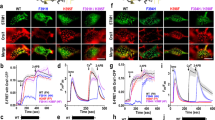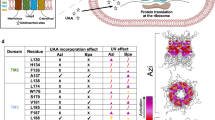Abstract
The Ca2+ release-activated Ca2+ (CRAC) channel pore is formed by Orai1 and gated by STIM1 after intracellular Ca2+ store depletion. To resolve how many STIM1 molecules are required to open a CRAC channel, we fused different numbers of Orai1 subunits with functional two-tandem cytoplasmic domains of STIM1 (residues 336-485, designated as S domain). Whole-cell patch clamp recordings of these chimeric molecules revealed that CRAC current reached maximum at a stoichiometry of four Orai1 and eight S domains. Further experiments indicate that two-tandem S domains specifically interact with the C-terminus of one Orai1 subunit, and CRAC current can be gradually increased as more Orai1 subunits can interact with S domains or STIM1 proteins. Our data suggest that maximal opening of one CRAC channel requires eight STIM1 molecules, and support a model that the CRAC channel activation is not in an “all-or-none” fashion but undergoes a graded process via binding of different numbers of STIM1.
Similar content being viewed by others
Log in or create a free account to read this content
Gain free access to this article, as well as selected content from this journal and more on nature.com
or
References
Lewis RS . Calcium signaling mechanisms in T lymphocytes. Annu Rev Immunol 2001; 19:497–521.
Parekh AB, Putney JW Jr . Store-operated calcium channels. Physiol Rev 2005; 85:757–810.
Liou J, Kim ML, Heo WD, et al. STIM is a Ca2+ sensor essential for Ca2+-store-depletion-triggered Ca2+ influx. Curr Biol 2005; 15:1235–1241.
Roos J, DiGregorio PJ, Yeromin AV, et al. STIM1, an essential and conserved component of store-operated Ca2+ channel function. J Cell Biol 2005; 169:435–445.
Feske S, Gwack Y, Prakriya M, et al. A mutation in Orai1 causes immune deficiency by abrogating CRAC channel function. Nature 2006; 441:179–185.
Zhang SL, Yeromin AV, Zhang XH, et al. Genome-wide RNAi screen of Ca(2+) influx identifies genes that regulate Ca(2+) release-activated Ca(2+) channel activity. Proc Natl Acad Sci USA 2006; 103:9357–9362.
Vig M, Peinelt C, Beck A, et al. CRACM1 is a plasma membrane protein essential for store-operated Ca2+ entry. Science 2006; 312:1220–1223.
Zhang SL, Yu Y, Roos J, et al. STIM1 is a Ca2+ sensor that activates CRAC channels and migrates from the Ca2+ store to the plasma membrane. Nature 2005; 437:902–905.
Prakriya M, Feske S, Gwack Y, Srikanth S, Rao A, Hogan PG . Orai1 is an essential pore subunit of the CRAC channel. Nature 2006; 443:230–233.
Vig M, Beck A, Billingsley JM, et al. CRACM1 multimers form the ion-selective pore of the CRAC channel. Curr Biol 2006; 16:2073–2079.
Yeromin AV, Zhang SL, Jiang W, Yu Y, Safrina O, Cahalan MD . Molecular identification of the CRAC channel by altered ion selectivity in a mutant of Orai. Nature 2006; 443:226–229.
Xu P, Lu J, Li Z, Yu X, Chen L, Xu T . Aggregation of STIM1 underneath the plasma membrane induces clustering of Orai1. Biochem Biophys Res Commun 2006; 350:969–976.
Luik RM, Wu MM, Buchanan J, Lewis RS . The elementary unit of store-operated Ca2+ entry: local activation of CRAC channels by STIM1 at ER-plasma membrane junctions. J Cell Biol 2006; 174:815–825.
Mercer JC, Dehaven WI, Smyth JT, et al. Large store-operated calcium selective currents due to co-expression of Orai1 or Orai2 with the intracellular calcium sensor, Stim1. J Biol Chem 2006; 281:24979–24990.
Park CY, Hoover PJ, Mullins FM, et al. STIM1 clusters and activates CRAC channels via direct binding of a cytosolic domain to Orai1. Cell 2009; 136:876–890.
Zhou Y, Meraner P, Kwon HT, et al. STIM1 gates the store-operated calcium channel ORAI1 in vitro. Nat Struct Mol Biol 2010; 17:112–116.
Ji W, Xu P, Li Z, et al. Functional stoichiometry of the unitary calcium-release-activated calcium channel. Proc Natl Acad Sci USA 2008; 105:13668–13673.
Mignen O, Thompson JL, Shuttleworth TJ . Orai1 subunit stoichiometry of the mammalian CRAC channel pore. J Physiol 2008; 586:419–425.
Penna A, Demuro A, Yeromin AV, et al. The CRAC channel consists of a tetramer formed by Stim-induced dimerization of Orai dimers. Nature 2008; 456:116–120.
Maruyama Y, Ogura T, Mio K, et al. Tetrameric Orai1 is a teardrop-shaped molecule with a long, tapered cytoplasmic domain. J Biol Chem 2009; 284:13676–13685.
Luik RM, Wang B, Prakriya M, Wu MM, Lewis RS . Oligomerization of STIM1 couples ER calcium depletion to CRAC channel activation. Nature 2008; 454:538–542.
Hogan PG, Lewis RS, Rao A . Molecular basis of calcium signaling in lymphocytes: STIM and ORAI. Annu Rev Immunol 2010; 28:491–533.
Yuan JP, Zeng W, Dorwart MR, Choi YJ, Worley PF, Muallem S . SOAR and the polybasic STIM1 domains gate and regulate Orai channels. Nat Cell Biol 2009; 11:337–343.
Mori MX, Erickson MG, Yue DT . Functional stoichiometry and local enrichment of calmodulin interacting with Ca2+ channels. Science 2004; 304:432–435.
Li Z, Lu J, Xu P, Xie X, Chen L, Xu T . Mapping the interacting domains of STIM1 and Orai1 in Ca2+ release-activated Ca2+ channel activation. J Biol Chem 2007; 282:29448–29456.
Soboloff J, Spassova MA, Tang XD, Hewavitharana T, Xu W, Gill DL . Orai1 and STIM reconstitute store-operated calcium channel function. J Biol Chem 2006; 281:20661–20665.
Muik M, Frischauf I, Derler I, et al. Dynamic coupling of the putative coiled-coil domain of ORAI1 with STIM1 mediates ORAI1 channel activation. J Biol Chem 2008; 283:8014–8022.
Zhou Y, Meraner P, Kwon HT, et al. STIM1 gates the store-operated calcium channel ORAI1 in vitro. Nat Struct Mol Biol 2010; 17:112–116.
Muik M, Fahrner M, Derler I, et al. A Cytosolic homomerization and a modulatory domain within STIM1 C terminus determine coupling to ORAI1 channels. J Biol Chem 2009; 284:8421–8426.
Peinelt C, Vig M, Koomoa DL, et al. Amplification of CRAC current by STIM1 and CRACM1 (Orai1). Nat Cell Biol 2006; 8:771–773.
Zheng J, Sigworth FJ . Intermediate conductances during deactivation of heteromultimeric Shaker potassium channels. J Gen Physiol 1998; 112:457–474.
Rosenmund C, Stern-Bach Y, Stevens CF . The tetrameric structure of a glutamate receptor channel. Science 1998; 280:1596–1599.
Sobolevsky AI, Rosconi MP, Gouaux E . X-ray structure, symmetry and mechanism of an AMPA-subtype glutamate receptor. Nature 2009; 462:745–756.
Ruiz ML, Karpen JW . Single cyclic nucleotide-gated channels locked in different ligand-bound states. Nature 1997; 389:389–392.
Dolmetsch RE, Lewis RS, Goodnow CC, Healy Ji . Differential activation of transcription factors induced by Ca2+ response amplitude and duration. Nature 1997; 386:855–858.
Dolmetsch RE, Xu K, Lewis RS . Calcium oscillations increase the efficiency and specificity of gene expression. Nature 1998. 392:933–936.
Chen Y, Deng Y, Zhang J, Yang L, Xie X, Xu T . GDI-1 preferably interacts with Rab10 in insulin-stimulated GLUT4 translocation. Biochem J 2009; 422:229–235.
Acknowledgements
We thank Professor Roger Y Tsien (University of California at San Diego, La Jolla) for providing the mOrange; Drs Bertil Hille, Erwin Neher, Michael Cahalan and Joy Fleming for careful reading and critical comments on the manuscript; Li Zheng and Junbing Wu for advice on western blotting; Drs Xiaolan Xu, Yong Yu and Lijun Chen for discussion during the project. This work was supported by grants from the National Science Foundation of China (30870564, 30630020), the Major State Basic Research Program of China (2006CB911001, 2010CB833701) and the CAS Project (YZ200838).
Author information
Authors and Affiliations
Corresponding authors
Additional information
( Supplementary information is linked to the online version of the paper on the Cell Research website.)
Supplementary information
Supplementary information, Figure S1
Schematic representation of the fluorescent constructs used in this study. (PDF 164 kb)
Supplementary information, Figure S2
SS constitutively activates Orai1 channels. (PDF 54 kb)
Supplementary information, Figure S3
Currents generated by Orai1-SS show characteristic properties of ICRAC. (PDF 78 kb)
Supplementary information, Figure S4
Orai1-derived constructs were expressed at similar levels in each set of experiments. (PDF 96 kb)
Supplementary information, Figure S5
Tethered SS in Orai1-SS are capable of fully activating the Orai1 channel. (PDF 67 kb)
Supplementary information, Figure S6
The LQ/AA mutation reduces the ability of the S domain in activating Orai1 channels. (PDF 40 kb)
Supplementary information, Figure S7
2×Orai1-L44-SS and 4×Orai1-L44-SS (the linker length between Orai1 and SS is 44 amino acids) generated similar currents in amplitudes as 2×Orai1-SS and 4×Orai1-SS, respectively. (PDF 91 kb)
Supplementary information, Figure S8
Orai1L273S-SS produced self-activated ICRAC and the currents decreased when the linker between Orai1 and SS was lengthened to 44 amino acids. (PDF 83 kb)
Supplementary information, Figure S9
Tethered SS domains activates the Orai1 channel as efficiently as soluble SS and WT STIM1, and are more potent than soluble SS domains in binding to Orai1. (PDF 26 kb)
Supplementary information, Data S1
Materials and Methods (PDF 13 kb)
Rights and permissions
About this article
Cite this article
Li, Z., Liu, L., Deng, Y. et al. Graded activation of CRAC channel by binding of different numbers of STIM1 to Orai1 subunits. Cell Res 21, 305–315 (2011). https://doi.org/10.1038/cr.2010.131
Received:
Revised:
Accepted:
Published:
Issue date:
DOI: https://doi.org/10.1038/cr.2010.131
Keywords
This article is cited by
-
Critical parameters maintaining authentic CRAC channel hallmarks
European Biophysics Journal (2019)
-
STIM1 activates CRAC channels through rotation of the pore helix to open a hydrophobic gate
Nature Communications (2017)
-
2-Aminoethoxydiphenyl Borate Potentiates CRAC Current by Directly Dilating the Pore of Open Orai1
Scientific Reports (2016)
-
Molecular mechanisms underlying inhibition of STIM1-Orai1-mediated Ca2+ entry induced by 2-aminoethoxydiphenyl borate
Pflügers Archiv - European Journal of Physiology (2016)
-
Discovery and structural optimization of 1-phenyl-3-(1-phenylethyl)urea derivatives as novel inhibitors of CRAC channel
Acta Pharmacologica Sinica (2015)



